A decent pair of dive boots has various advantages for any diver. Dive boots defend against coral reef wounds and sharp rocks. They make shore entrances less unpleasant, offer warmth, and allow divers to dive for longer periods in colder weather.
Furthermore, diving boots should provide stability, strength, and comfort to the areas of the foot responsible for carrying heavy dive gear. Therefore, the finest dive boots provide enough protection without sacrificing comfort. They are also long-lasting and will serve you well for a long time.
| Diving Boots | Brand | Our Rating | Check Price on Amazon |
|---|---|---|---|
 | Mares Non-Slip Rubber Sole Boot | [su_button url="https://www.amazon.com/Mares-Equator-2mm-Dive-Boots-10/dp/B002SEE07A?tag=beka3687-20" target="blank" style="default" background="#E03F00" color="#FFFFFF" size="5" wide="no" center="no" radius="auto" icon="" icon_color="#FFFFFF" text_shadow="none" desc="" onclick="" rel="" title="" id="" class=""]Check Price[/su_button] | |
 | Neo-Sport Puncture Resistant Sole Boot | [su_button url="https://www.amazon.com/Neoprene-puncture-resistant-moderate-watersports/dp/B000V9JSKI?tag=beka3687-20" target="blank" style="default" background="#E03F00" color="#FFFFFF" size="5" wide="no" center="no" radius="auto" icon="" icon_color="#FFFFFF" text_shadow="none" desc="" onclick="" rel="" title="" id="" class=""]Check Price[/su_button] | |
 | Cressi Anti-Slip Sole Boots | [su_button url="https://www.amazon.com/Cressi-Minorca-3mm-black-12/dp/B00FS5RPIM?tag=beka3687-20" target="blank" style="default" background="#E03F00" color="#FFFFFF" size="5" wide="no" center="no" radius="auto" icon="" icon_color="#FFFFFF" text_shadow="none" desc="" onclick="" rel="" title="" id="" class=""]Check Price[/su_button] | |
 | Xuker Water Boots | [su_button url="https://www.amazon.com/NeopSkin-Neoprene-Volleyball-Swimming-Snorkeling/dp/B08C4NLXHQ?tag=beka3687-20" target="blank" style="default" background="#E03F00" color="#FFFFFF" size="5" wide="no" center="no" radius="auto" icon="" icon_color="#FFFFFF" text_shadow="none" desc="" onclick="" rel="" title="" id="" class=""]Check Price[/su_button] | |
 | Tilus Ergonomic Scuba Boots | [su_button url="https://www.amazon.com/Tilos-Ergonomic-Available-Titanium-Thermowall/dp/B07BB66S57?tag=beka3687-20" target="blank" style="default" background="#E03F00" color="#FFFFFF" size="5" wide="no" center="no" radius="auto" icon="" icon_color="#FFFFFF" text_shadow="none" desc="" onclick="" rel="" title="" id="" class=""]Check Price[/su_button] |
The Reason for Wearing Diving Boots
Dive boots, also known as wetsuit boots or booties, are worn by scuba divers and snorkelers for warmth, comfort, and protection. So, diving boots are intended to be used with open-heel dive fins that include an adjustable heel strap to keep the fin in place on the foot. But dive boots are not required if you utilize closed-heel fins.
Above all, surfing, kayaking, sailing, and other water activities also make use of dive boots.
BEST DIVING BOOTS – TOP 5 CHOICE
OUR NUMBER 1 CHOICE
[wp-review id=”3493″]
The Contenders
[su_service title=”Neo-Sport Puncture Resistant Sole Boot” icon=”icon: star” icon_color=”#2D3092″ size=”32″ class=””][/su_service]
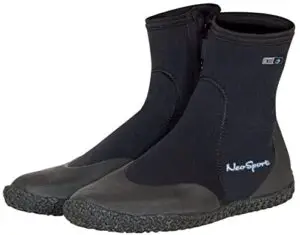
A multi-purpose neoprene boot/shoe with a puncture-resistant sole that provides heat protection and foot support for all of your aquatic activities. So, tough, zip-up uppers are bonded and sewed to a high traction sole ideal for boat decks, sandy beaches, and any wet or muddy surface.
Additionally, a water-entry barrier keeps water from quickly entering the boot via the zipper. Moreover, to enhance safety, there is a durable bonded and sewed construction feature.
So, this multipurpose footwear can be used not just for diving but also for any other aquatic adventure. So, they can keep you on your feet even when you’re knee-deep in muck.
It is both comfortable in and out of the water and has excellent traction on a boat. So, it should be totally dry by the next day and ready to use.
[su_service title=”Cressi Anti-Slip Sole Boots” icon=”icon: star” icon_color=”#2D3092″ size=”32″ class=””][/su_service]
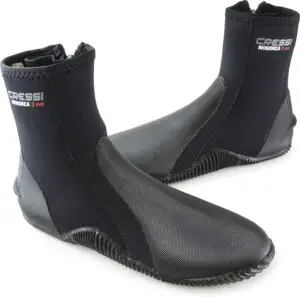
The Cressi Anti-Slip Sole Boots are lightweight shoes that are great for outdoor activities and travel. Moreover, it is made of Super Elastic Neoprene for the optimum comfort within the sole. It is built to provide extra comfort while still being extremely durable.
The sole is made of durable rubber to prevent slippage on damp or flat surfaces. Moreover, it sports a rubber heel and toe cap for increased strength and durability. But they are appropriate for surfing, kayaking, scuba diving, and other water activities. So, after usage, rinse well with clean water before drying.
The grip is excellent for keeping you on a board while letting you move about freely. Therefore, this is one of the finest diving boots available on the market today.
[su_service title=”Xuker Water Boots” icon=”icon: star” icon_color=”#2D3092″ size=”32″ class=””][/su_service]

This boot boasts a strong sole, as well as heel and toe protection. Moreover, they fit well, keep sand and grit out, and have been strengthened in the sole for further comfort and longevity.
Additionally, the glued blind stitching prevents water from entering and keeps your feet much more comfortable while participating in water sports.
Moreover, the sock openings are made of smooth neoprene skin. So, it is primarily used for diving and triathlon suits and is high-quality, soft, comfortable, and anti-slip.
Therefore, bottoms are made using a coating procedure, which makes them considerably more abrasion-resistant; you may easily stroll on the beach or in the water while wearing these neoprene socks.
[su_service title=”Tilus Ergonomic Scuba Boots” icon=”icon: star” icon_color=”#2D3092″ size=”32″ class=””][/su_service]
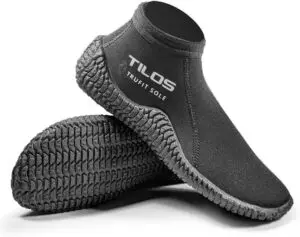
At first, the Tilos Trufit Boots may seem overly small or tight.
It has a lesser volume than most boots that have been on the market for a long time. So, divers who have never worn diving boots before will adore them.
Experienced divers may be more likely to believe they are too tight. With a diving boot, you want a tight fit. So, it gives you extra support and a warmer boot.
Quick Tips in Choosing Diving Boots

✔ Keep the Fins in Mind
You should buy your diving boots at the same time as your fins. Or, at the very least, bring your fins with you to confirm they fit correctly while you’re booting up. But most likely, you’ll require larger-than-normal fins.
✔ The Size
Diving boots, predictably, come in sizes comparable to your shoe size. So, they should fit snugly, without pinching, much like your shoes.
They may certainly be a little stiff at first, like most new dive gear, but they should never be unpleasant. But it may fill with water if they are overly large, causing chilled feet and reduced fin control.
So, if they are too tiny, they may limit your blood circulation and cause your feet to become chilly, but they will also rub, which is irritating and distracting.
✔ The Length
Scuba boots, predictably, come in sizes comparable to your shoe size. But they should fit snugly, without pinching, much like your shoes. So, it may certainly be a little stiff at first, like most new dive gear, but they should never be unpleasant.
Additionally, they may fill with water if they are overly large, causing chilled feet and reduced fin control.
So, if they are too tiny, they may limit your blood circulation and cause your feet to become chilly, but they will also rub, which is irritating and distracting.
✔ The Zips and Seams
When it comes to diving boots, you have two options: zipped or zipless. Also, zips are considerably easier to put on, yet zipless are less expensive. But at the end of the day, the style you pick is a matter of personal taste.
If you pick zippered booties, be sure the zipper has a backing that will keep cold water out of the boots. So, check sure the seams are watertight as well since this will keep your feet warmer.
Moreover, the best scuba boots have glued blind stitched, or liquid taped seams.
✔ Budget
The majority of diving booties on the market provide high-quality items at a reasonable price. So, the more you invest, the higher the quality of the booties you will receive.
As a result, you should put aside sufficient money and conduct careful research to get the best dive booties that fit you.
How to Clean Your Diving Boots Properly
It is easy to neglect to care for diving boots after purchasing them. So, scuba boots, fortunately, are simple to maintain.
◐ Rinse it
Rinse your scuba diving boots in clean water. Moreover, the presence of saltwater might cause neoprene to lose its pliability. Additionally, the unpleasant odor that unrinsed neoprene might emit.
◐ Soak it
When you arrive home, soak your scuba boots for around 15 minutes. At this time, you can also use a special wet suit shampoo or a gentle baby shampoo. But it’s also a good idea to rinse your boots with a mixture of water and a mild disinfectant regularly.
◐ Check for Damage
Check for rips or tears in your diving boots before storing them for the next dive trip. Moreover, they are much easier to correct while they are little, but they become a major issue if you only discover them when putting them on right before a dive.
◐ Store it
Do not crumple up boots and stuff them in a drawer or put them under heavy equipment. This can cause creases in the boots, resulting in both damage and insulation loss. So, store or dry your diving boots away from direct sunshine.
What Are the Benefits of Wearing Diving Boots?
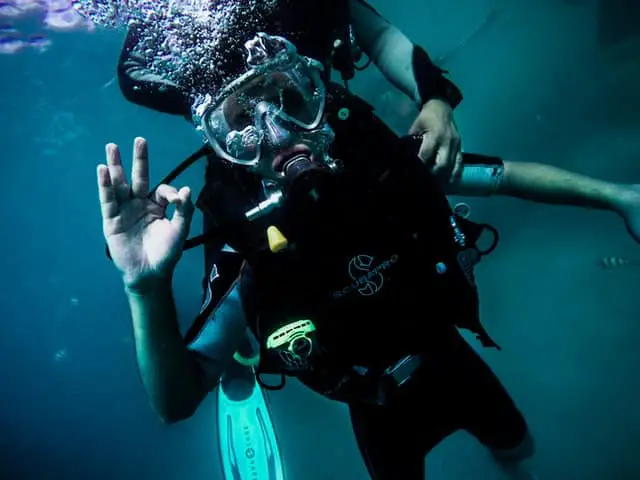
▶ Protection
With 30 pounds on my back, I walked to the entry point. So, walking on pebbles and shells becomes much more difficult with dive gear on your back. So, your dive boots’ rubber bottoms protect your feet from scratches, burns, bites, and stings while also providing extra grip on slick conditions.
Moreover, falling on jagged rocks, especially when carrying large gear, can result in significant injury and damage to your pricey equipment.
▶ Comfort
Wearing these sorts of fins without diving boots can cause muscle strain, cramping, and chafing on your skin. Therefore, the boots cushion your toes, toenails, and toe knuckles from the harsh interior of the fin cup.
Finally, the buckles, strap, and edges of the cup may brush against your arch, heel, and other portions of your foot as you move, irritating your skin and creating irritation, blisters, or abrasions.
▶ Warmth
Dive boots collect water, acting as an insulator to maintain your body heat close to your skin. Dive boots keep your ankles, feet, and toes toasty when you’re in and out of the water.
When you get chilly, your blood flow to your skin and extremities is restricted to save body heat. So, this causes your fingers and toes to feel cold.
Thin 2 mm to 3 mm booties are generally sufficient in warmer water, above 75 degrees F, to keep your toes toasty.
Keeping your feet warm can also help avoid cold-water-caused foot and calf cramps.
▶ Construction
The thickness of the material ranges from 2 mm to 7 mm. As a result, low-top booties begin just below the ankle, whereas high-top booties completely cover the ankle. Also, dive boot soles come in a range of thicknesses.
So, to make putting on the boots simpler, they may have zippers, hook-and-loop closures, or elastic tops.
Basic Diving Gears
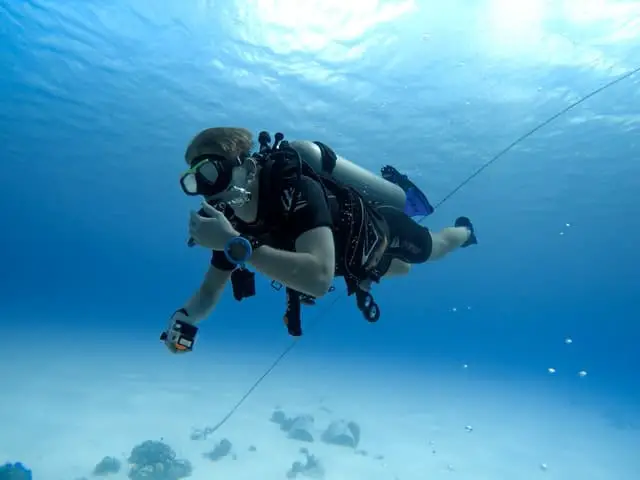
➝ The Wetsuit
While wetsuits come in a variety of styles and cuts, the most popular wetsuits worn by scuba divers are complete wetsuits and shorties.
You can wear the wetsuits directly. So, wetsuits can cause chafing, therefore swimwear can provide additional protection.
➝ The Dive Boots
Scuba divers wear dive boots, sometimes known as dive booties, to protect their feet on land and underwater.
Divers who want to wear open-heel fins for scuba diving should also invest in a nice pair of diving boots. Moreover, to protect your feet from frigid temperatures, you may choose low or high-cut diving boots in various neoprene thicknesses.
Divers who frequent regions with rough or jagged rocks can also use diving boots with stronger soles.
➝ The Dive Socks
Dive socks give extra warmth and protection to your feet. So, to avoid chaffing, use scuba socks with your diving booties or complete foot fins.
➝ The Scuba Diving Gloves
Divers use scuba diving gloves to shield their fingers and hands from cold water temperatures, animal stings and bites, and sharp objects and conditions underwater.
➝ Hoods
Dive hoods are another piece of scuba diving equipment that divers use to keep warm. Moreover, they are available in a variety of neoprene thicknesses to protect a diver’s head and neck from cold water temperatures.
You may also choose a hood that comes with a vest to keep your body warm.
➝ The Drysuit
Drysuits are another piece of protective equipment that divers use to keep warm in cooler water conditions. Scuba divers typically wear dry suits when the temperature falls below 10°C.
Drysuits, as opposed to wetsuits, employ a layer of air to assist keep the body insulated.
Divers would still need to wear thermals under their drysuits to stay warm.
Frequently Asked Questions
Q: What do diving boots go by?
A: It is known as wetsuit boots and is worn by scuba divers for warmth.
Q: What are the purposes of dive booties?
A: They are meant to be flexible and may be worn with open-heeled fins. So, this is to minimize chaffing and protect your feet from jagged coral and rocks.
Q: Do you put socks on with your dive boots?
A: Socks can be worn with them. And because diving boots do not fit as securely on your feet as dive socks do, they might cause friction and chafing.
Q: Do you use diving boots and fins?
A: It is all up to your preference and what you are comfortable with.
Q: How snug should diving boots be?
A: It should be snug, but not too tight or too loose.
Final Thoughts
The diving boots described above are among the best on the market today. We have narrowed it down for you so that you may spend less time and energy looking for the correct one.
The booties should fit your feet snugly but pleasantly inside the fin cups, without crushing them.
